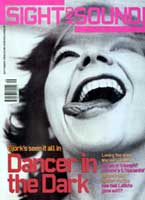Primary navigation

Japan 1997
Reviewed by Mark Kermode
Our synopses give away the plot in full, including surprise twists.
Tokyo, 5 Sept 1997. High-school pupil Tomoko dies after telling a friend that a week ago she watched a video, then got a phone call saying she would perish seven days later. 13 Sept : television reporter Reiko, mother to Yôichi and aunt to Tomoko, travels to the cabin in Izu where Tomoko saw the tape. Reiko watches the tape and then receives a phone call.
14 Sept: Reiko's ex-husband Ryûji watches the tape. 15 Sept: Ryûji has a vision of Tomoko and discovers a voice on Reiko's copy of the tape. 16 Sept: Ryûji recognises that the voice's dialect belongs to the island of Oshima. Here, a psychic woman named Shizuko threw herself into a volcano whose eruption she had predicted 40 years ago. 17 Sept: Reiko takes her son Yôichi to her father's house, where Yôichi watches the tape, allegedly upon instructions from Tomoko. 18 Sept: Reiko learns of Dr Ikuma whose ESP experiments on Shizuko ended in scandal. 19 Sept: having traced Shizuko's father, Reiko views a tape in which Shizuko's daughter Sadako kills a man with her thoughts. Reiko and Ryûji deduce that Dr Ikuma fathered Sadako and took her following Shizuko's death.
20 Sept: at Izu, exactly a week after first watching the tape, Reiko (with Ryûji's help) uncovers a well where Sadako's body has lain since she was murdered by Ikuma. Believing the curse to be lifted the pair return home. 21 Sept: Ryûji is killed by an apparition of Sadako and Reiko realises that the curse can only be broken if the viewer of the tape shows it to someone else within seven days. To save Yôichi, she drives to her father's house to show him the tape.
[Editor's note: this review reveals one of the film's surprises.] "Who did the story start with?" asks heroine Reiko midway through this riveting amalgam of modern urban myth and ancient eastern legend, a Japanese answer to The Blair Witch Project which sets a ghoulish leer of delight on the face of its ever widening audience. "Stories like that don't start with anyone," replies her ex-husband Ryûji. "People feel anxious and rumours start flying. Or people start hoping that things will turn out like this." From the off, Ring keeps its audience guessing but, by the end, few could have predicted things would turn out so hellishly well.
Based on a best-selling horror pot-boiler by Kôji Suzuki, Ring became the highest-grossing horror film in Japanese history when it was released in 1998, bringing to mind the success of Daniel Myrick and Eduardo Sanchez's off-beat low-budget shocker in the US. Originally double-billed with its sequel, Ring has become a cult in the East where dolls of Sadako - the murderous child-ghost at the murky heart of Ring's narrative - are reputed to be as popular as Freddy Krueger gloves in the West. Such adulation is not undeserved. Even after the UK releases of both Blair Witch and The Last Broadcast, Ring remains compelling viewing, a stark treat which looks back to the austere black and white rituals of Kaneto Shindo's unsettling samurai film Onibaba (1964), and sideways to the teen-slasher terrors of such films as Scream.
Director Hideo Nakata manages to strike a genuinely alarming balance between the cultural depths of Japanese folklore and the surface sheen of latter-day teen culture. With its video curses, late-night television links and matter-of-life-or-death phone calls, Ring has more than enough techno-friendly trappings to ensnare the average channel surfer. But lurking at the bottom of its well of intrigue is a timeless terror more attuned to the mature sensibilities of an adult audience. And it is this unique combination of old folk devils and contemporary moral panics which gives Ring such a nerve-rattling edge.
Having served his apprenticeship at the Nikkatsu Corporation (an exploitation house which nevertheless produced such avant-garde classics as Seijun Suzuki's Tokyo Drifter, 1966) Nakata demonstrates a broad knowledge of the international horror genre, winking his eye toward the viral screen imagery of David Cronenberg's Videodrome, and lending his ear - or at least that of Kinji Kawai (who scored the film) - to the atonal clatterings of Krzysztof Penderecki (used to fine effect in The Shining), and the synthesised wails of director Dario Argento's music group Goblin. But his finest moments are entirely his own; it is hard to imagine anyone else making such ghastly use of a jerky, faceless human form during the apparitions of Sadako, and the sequence in which her spirit literally crawls out of the television set will scare the living hell out of you. No amount of high-tech special effects could match the balletic awfulness of this painfully simple sequence, which tops Poltergeist in the creepy cathode-ray stakes.
Whether the US remake of Ring will have anything like the same impact remains uncertain. Although Suzuki's story has clear transatlantic potential, one is inclined to conclude that it is the telling, rather than the content of the tale, that is all-important. If the medium is indeed the message, then the message may well be that certain terrors can only be seen through the eyes of visionaries like Nakata.